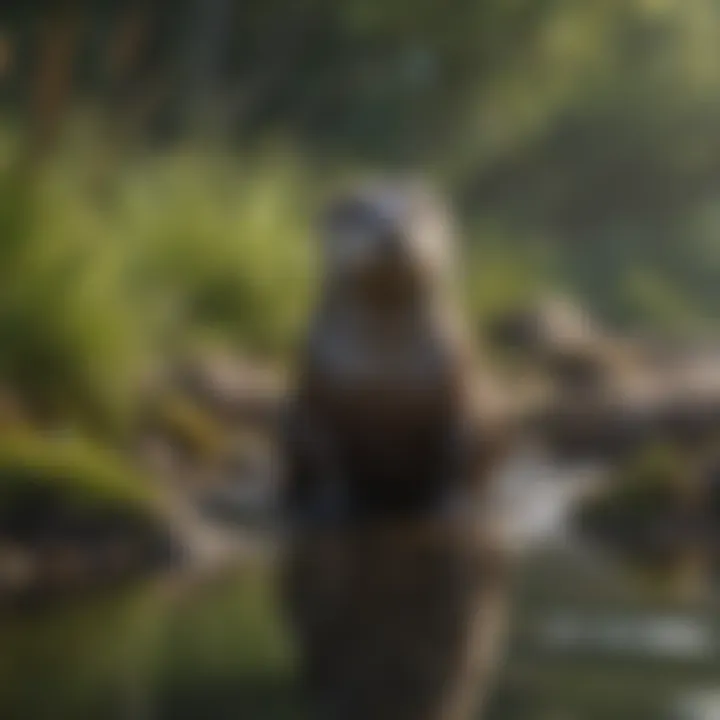Exploring the Habitat and Distribution of Otters


Overview of the Topic
Otters are fascinating creatures that inhabit various ecosystems across the globe. These semi-aquatic mammals play a vital role in their environments, and understanding their habitats is crucial for conservation efforts. When we talk about otters, we don't just think of one species, but rather a diverse family that includes river otters, sea otters, and more, each adapted to its unique setting.
The ecological significance of otters can't be understated. They serve as indicators of environmental health, acting as a barometer for the conditions of their habitats. Healthy otter populations often suggest a balanced ecosystem, while declines can signify larger environmental issues at play. This article takes a closer look at where otters are found, the types of habitats they require, and the critical threats they face.
Current Status and Challenges
When we evaluate the current status of otter populations, it's clear that they are not out of the woods yet. Habitat loss is a significant concern. Urban development, pollution, and climate change wreak havoc on the delicate environments wild animals like otters depend upon. For instance, river otters, often spotted along streams and rivers, require clean water to thrive. But run-off from agriculture and industry pollutes these water bodies, leading to a decline in food sources.
Additionally, the threats may extend beyond immediate habitat concerns. Fishing practices, like gill-netting, inadvertently catch otters, causing injuries or death. Moreover, in certain areas, poaching remains a grim reality.
"Otters are not just charming; they're critical for biodiversity. Loss of otter populations reflects deeper ecological imbalance."
Sustainable Solutions
It's not all doom and gloom. There are ongoing efforts aimed at preserving otters' habitats and ensuring these creatures continue to roam our waters. One of the standout solutions is the establishment of protected areas. These are regions where human activities are limited or closely monitored to safeguard wildlife.
Community-engaged conservation projects are also gaining traction. In some regions, locals are involved in monitoring otter populations and restoring habitats. For instance, initiatives in Scotland and parts of the Pacific Northwest focus on restoring riparian zones to improve water quality and provide natural shelters for otters and other species.
- Restoration of wetlands
- Clean-up projects for local rivers and lakes
- Educational programs for fishermen
Examples of Success
Numerous case studies show the effectiveness of these measures. The revival of the sea otter population along the coasts of California is a notable example. After extensive conservation efforts, these otters have bounced back, helping restore kelp forests by controlling sea urchin populations.
Impact and Importance
The implications of preserving otter habitats stretch far and wide. These animals do not exist in a vacuum; their presence affects the biodiversity of their ecosystems. When otter populations thrive, we can infer a rich and balanced ecosystem, one that supports various species – from fish populations to plant life.
Moreover, conserving these creatures contributes to the ecological stability that communities depend upon. Healthy otter populations can boost local economies through eco-tourism, as nature enthusiasts flock to see these aquatic mammals in the wild.
As we advance into a future that's increasingly shaped by human activity, it becomes crucial to recognize the role otters play — not just as captivating wildlife, but as essential components of our global ecology. Emphasizing conservation efforts and sustainable practices is paramount, ensuring that generations to come can also experience the beauty and significance of otters in the wild.
Prelims to Otters
Otters are remarkable creatures that capture the fascination of conservationists and nature enthusiasts alike. Their playful demeanor and adaptability to various aquatic environments are just a couple of the traits that make them worthy of study. This section focuses on the significance of otters in ecosystems, offering insights into their role as indicators of environmental health. Understanding otters is essential, not merely for appreciating their charm, but for grasping the intricate web of life within their habitats.
General Overview
The otter, a member of the family Mustelidae, exhibits diverse features depending on the species. Ranging from the agile North American River Otter, to the robust Sea Otter often spotted floating on its back while cracking shells on its belly, each presents unique adaptations suited to their respective ecosystems. Otters are typically found in freshwater and coastal habitats across the globe. They thrive in environments that range from rocky shorelines to serene ponds.
Their lifestyle dictates specific habitat requirements, heavily influenced by water quality, prey availability, and foliage. This wide-ranging habitat preference reflects not just a capacity for survival but an ecological necessity that plays into the overall health of their ecosystems.
Importance in Ecosystems
Otters occupy a crucial niche in their ecosystems, acting as both predators and prey. Their dietary habits alone exhibit their role in maintaining the balance within aquatic systems. By preying on fish, crustaceans, and even invasive species, otters help regulate populations, fostering biodiversity.
- Indicators of Water Quality: Otters are sensitive to changes in their environment, particularly to pollution levels. Their presence often signals a healthy ecosystem, while a decline in their population can indicate water quality issues. This aspect makes them valuable for conservation efforts, as tracking their populations can yield insights into the health of aquatic ecosystems.
- Ecological Engineers: Beyond being mere indicators, otters contribute to their environment by influencing prey populations. For instance, their hunting can affect the dynamics of fish communities, ensuring that no single species dominates.
"The presence of otters in an ecosystem can indicate overall health and stability, making their conservation a priority for environmentalists."
Otters also engage in behavior that enhances habitats, such as creating dens along riverbanks or coastlines, which can help improve the ecological complexity of their environments. This nurturing aspect rounds out their role in the ecosystem, reflecting how interconnected life is at every level.
In summary, understanding otters not only enriches our knowledge of biodiversity but also underscores their significance as guardians of aquatic health. Their playful yet impactful existence continues to remind us of the importance of preserving their natural environments from the threats of pollution, habitat destruction, and climate change.
Global Distribution of Otter Species
Understanding the global distribution of otter species is pivotal for a variety of reasons. It sheds light on how otters have adapted to their environments and provides insights into this species’ ecological needs. These traits are essential to preserving their populations and habitats in the face of increasing environmental challenges. One of the most significant aspects is recognizing the various species that inhabit different regions, as well as the unique adaptations they exhibit.
Overview of Species Diversity
Otters belong to the family Mustelidae and encompass numerous species scattered across various continents. Ranging from the well-known American River Otter to the lesser-known Eurasian Otter, the diversity among these creatures is remarkable. Each species has its charm and specific characteristics.
For example, the North American River Otter (Lutra canadensis) thrives in a range of environments including rivers, lakes, and coastal areas throughout the United States and Canada. In contrast, the Sea Otter (Enhydra lutris), renowned for its thick fur and floating habits, is found along the Pacific coasts, from Alaska down to California. These adaptations reflect their unique ecological niches and the habitats they occupy.
- Main Otter Species:
- North American River Otter
- Sea Otter
- Eurasian Otter
- Giant River Otter
- Smooth-Coated Otter
Identifying these species is crucial for targeted conservation strategies. Each species plays a role in its ecosystem, participating in food webs and influencing the health of aquatic systems. What’s more, some species are indicators of environmental health; when one otter species flourishes, it often means the overall ecosystem is in robust condition.


Regional Differences
The distribution of otter species varies markedly across geographical regions largely due to differences in climate, food availability, and human activity. In North America, the river otter can be spotted in a plethora of wetland habitats making it adaptable, whereas in Europe, the Eurasian Otter roams across rivers and lakes, but is often hindered by habitat fragmentation.
In Asia, the Lesser Otter (Aonyx cinerea) is distinctive for its smaller stature. These otters primarily inhabit shallow waters like rivers and marshes, but their numbers are threatened by habitat loss. Meanwhile, the Himalayan Otter (Lutra lutra) has another set of preferences, often climbing up into the chilly streams of mountain regions, reflecting the diverse adaptations across species.
- Key Regional Differences:
- North America: Dominance of River Otters in freshwater systems.
- Europe: The Eurasian Otter is widespread, but faces habitat challenges.
- Asia: Species like the Lesser and Himalayan Otters highlight diversity in preference from wetlands to cold streams.
- Africa: African otters, while less documented, are essential to their respective ecosystems, showcasing a unique blend of adaptations.
Knowing the distribution helps in understanding how to alleviate the threats specific to each region, be it pollution regulation or habitat preservation.
Habitat Types
Understanding the various habitat types where otters thrive is essential for grasping their ecological requirements and the challenges they face in their environments. Each habitat offers unique attributes that shape the lives of otters, influencing their behavior, feeding habits, and reproduction. From freshwater ecosystems to coastal regions and wetlands, the versatility of otters in adapting to diverse environments is remarkable and underscores their ecological significance. Therefore, exploring these habitat types helps highlight the importance of preserving the natural environments that sustain otter populations and the broader ecosystems they inhabit.
Freshwater Habitats
Rivers and Streams
Rivers and streams are crucial living spaces for otters, serving as dynamic ecosystems that offer plenty of food and shelter. These flowing bodies of water provide a rich variety of prey, including fish, amphibians, and crustaceans. A notable characteristic of rivers is their constant movement, which helps to keep the water oxygenated, creating ideal conditions for aquatic life. This makes rivers a popular choice in this discussion, as they not only support otters but also a wide range of other species.
An important feature of rivers and streams is their complex structure, which includes pools, riffles, and eddies that otters utilize for hunting and playing. The diversity in flow speeds allows otters to exploit their hunting skills across different water conditions, enhancing their hunting success. One might say the reason rivers are pivotal for otters is that they allow for both relaxation and critical feeding opportunities. However, the rapid flow can pose challenges during droughts or heavy rains, impacting the availability of food and reducing safe havens for the otters.
Lakes and Ponds
Lakes and ponds provide a starkly different environment compared to rivers and streams yet are equally vital for otters. They often contain still water that fosters rich ecosystems centered around aquatic plants, fish, and other aquatic creatures. A significant characteristic of lakes is their stability, which allows for the establishment of complex food webs. This stability is appealing in this article as it highlights how otters can rely on predictable feeding patterns.
One unique feature of lakes and ponds is the presence of abundant vegetation along the shores, offering excellent cover for otters not just for hunting, but also for establishing dens. Having such shelter is extremely advantageous as it helps with breeding and rearing young otters. Nonetheless, lakes and ponds can be adversely affected by pollution and invasive species, which can drastically affect the health of these ecosystems and pose a threat to otter survival.
Coastal Habitats
Marine Environments
Marine environments encompass coastal areas where otters often take advantage of diverse ecosystems. The rich biodiversity found in nearshore marine environments supports various otter species, especially sea otters. This habitat type contributes significantly to the otter populations, as kelp forests and rocky reefs provide abundant food and protection from predators.
A remarkable feature of marine environments is their interconnectedness with other habitats. For example, otters often forage in these waters but require access to sandy or rocky coasts for resting and shelter. The adaptability of otters to these varied environments illustrates their ecological flexibility but also exposes them to challenges, such as pollution from maritime activities, which can disrupt their food sources.
Estuaries
Estuaries serve as a fascinating blend where freshwater meets saltwater, creating unique ecosystems that are incredibly productive. Otters thriving in estuarine habitats benefit from diverse food sources due to the mixing of freshwater species and marine life. This aspect is key in our exploration of habitats since estuaries act as nurseries for many fish species, enhancing the availability of prey for otters.
A distinguishing characteristic of estuaries is their dynamic nature, which includes changing tides and sediment dynamics that shape the environment. This provides variability in prey availability, offering otters different hunting scenarios throughout the day. However, the fragile nature of estuarine habitats can be burdensome, as they are often at risk from development and pollution impacts, directly affecting the otter populations that rely on them.
Wetland Ecosystems
Swamps and Marshes
Swamps and marshes represent an important transitional habitat for otters, offering a mosaic of aquatic and terrestrial features. These wetlands are characterized by their waterlogged soils and abundant vegetation, which provide ample cover and hunting grounds. This is particularly beneficial for otters as it supports a variety of prey species, including birds, amphibians, and small mammals.
A unique aspect of swamps and marshes is their ability to filter pollution, acting as natural water purifiers. This contributes not only to the health of the aquatic creatures that live there but also to otters, who rely on clean water for their survival. Yet, the drawback lies in the vulnerability of these habitats to drainage and conversion for agricultural purposes, which leads to habitat loss and has a pronounced impact on otter populations.
Bogs and Fens
Bogs and fens differentiate themselves as more specialized wetland types that provide essential functions. These habitats hold nutrient-deficient waters, which can create unique ecosystems that otters may occasionally visit. The primary characteristic of bogs is their acidic nature, making them less favorable for many species but supporting specific flora that otters might utilize for shelter.
One unique characteristic of fens is their capacity to store carbon, contributing to climate regulation—an essential consideration in the context of habitat conservation. Still, they may not consistently provide the rich food sources found in other wetland types, leading to less frequent otter visits. The rare and specific nature of bogs and fens makes them interesting in discussing the full scope of otter habitats, though their conservation needs require particular attention due to their declining overall acreage.
Geographical Distribution
Understanding the geographical distribution of otters is crucial for grasping their ecological roles and the habitats they thrive in. The distribution patterns unveil insights into how different species adapt to their surroundings and what environmental factors influence their populations. Each region showcases unique characteristics that not only affect otters' survival but also reflect broader environmental changes.
Determining where otters can be found involves considering a mix of water quality, prey availability, and habitat structures. Such factors draw the line between survival and decline, leading to an essential examination of how these fascinating creatures interact with and depend on their ecosystems.
North American Otters
River Otters
In North America, river otters are a notable presence, particularly due to their adaptability to various freshwater systems. Their streamlined bodies make them exceptional swimmers, often seen gliding gracefully through rivers and streams. These otters typically favor habitats with abundant vegetation, which provides cover from predators and plays a crucial role in their foraging habits.
The river otter’s keen sense of smell aids in locating prey, which includes fish, crustaceans, and even small mammals. A critical aspect of their behavior is their ability to travel significant distances between water bodies, which can indicate healthy ecosystems. This adaptability makes them a vital indicator species, providing insights into the health of freshwater habitats. River otters also show unique social behaviors, often seen in playful interactions or family groups, showcasing their intelligence and curiosity.
Sea Otters


Conversely, sea otters inhabit coastal regions, especially along the Pacific Coast, making them beloved icons of marine ecosystems. They are notable for their thick fur, which serves as insulation against cold waters, a key adaptation when diving for food. Sea otters primarily feed on sea urchins, crabs, and mollusks, playing an important role in the ecological balance of kelp forests by controlling prey populations.
A defining characteristic of sea otters is their use of tools; they cleverly use rocks to crack open shellfish. This unique behavior not only showcases their intelligence but also sets them apart in discussions of animal cognition. However, their populations have been historically endangered due to fur trading and current threats like oil spills, highlighting the need for extensive conservation efforts.
European Otters
Moving across the Atlantic, European otters are present throughout many parts of Europe. Their habitats can vary significantly from riverbanks in rural areas to urban settings, indicating their adaptability. However, similar to their North American counterparts, they depend heavily on clean, quality freshwater and diverse prey sources. The conservation status of European otters has improved over the years thanks to dedicated efforts and legal protections, demonstrating the success of targeted conservation strategies.
Asian Otter Species
Lesser Otter
In Asia, the lesser otter stands as a unique species that displays distinct behaviors compared to its relatives. Recognized for their smaller build, they inhabit various fresh and brackish water bodies across multiple countries. This adaptability signifies a broader ecological versatility, allowing lesser otters to thrive in varying environments, from rivers to rice paddies. Their diet primarily consists of fish and insects, showcasing a specialized feeding habit that helps maintain the balance in local ecosystems.
Himalayan Otter
Another Asian species, the Himalayan otter, is notable for its rugged habitat preference, found in the cold rivers of the Himalayas. This otter has adapted to the harsh conditions, embodying resilience in extreme climates. However, the possible climate changes pose threats to their habitat, making ongoing research essential. Their presence is indicative of the health of pristine waters, challenging us to recognize the threats that arise from environmental degradation.
African Otters
Finally, in Africa, otters such as the African clawless otter are primarily found in tropical and sub-tropical areas. Their habitats range from rivers to coastal shores, showcasing their ecological diversity. African otters often face challenges due to habitat loss and local human activity, which disrupts their natural behaviors. Understanding each species' distribution helps researchers and conservationists to strategically focus their efforts in preserving both otters and their habitats, ensuring the longevity of these remarkable creatures.
Environmental Conditions Favoring Otter Habitats
Otters that frolic in rivers, lakes, and estuaries undoubtedly thrive in specific environmental conditions. Understanding these factors is vital in appreciating how otters adapt and flourish in their habitats. Without a doubt, the quality of the water and surrounding vegetation plays a pivotal role. The ability of otters to find food, shelter, and safe breeding grounds hinges on the balance of these elements. Thus, examining the environmental conditions offers insights into how to protect and restore these habitats effectively.
Water Quality Parameters
Temperature
When we think about temperature, we often overlook its subtle yet profound effects. The temperature of water bodies can significantly impact freshwater and coastal otters, influencing their behavior, metabolism, and overall health. Generally, otters prefer water temperatures that range from cool to temperate. This preference is not just a whimsical choice; it’s essential for their physiological processes. For instance, warmer water can lead to lower oxygen levels, which can be detrimental not just to otters but to the broader aquatic ecosystem.
One unique feature of temperature is its role during breeding seasons. Certain otter species time their mating with seasonal temperature fluctuations, providing optimal conditions for their pups. However, increased water temperature may also lead to challenges like increased competition for prey or habitat loss.
Oxygen Levels
Just like humans need fresh air, otters rely on adequate oxygen levels in the water. Oxygen is crucial, especially for those hunting in rivers or streams where turbulent water often holds more oxygen. A classic trait of healthy aquatic ecosystems is high dissolved oxygen, which supports a rich diversity of aquatic life, providing a smorgasbord for otters.
However, what happens when oxygen levels decline? Fish and crustaceans, beloved prey for otters, can diminish in number, leading to food shortages. Moreover, stagnant waters often indicate lower oxygen levels, which could pose hardshore challenges for otters. Thus, striking a balance in oxygen levels is fundamental for the survival of otters in any given habitat.
Vegetation and Shelter Availability
Imagine a world where otters have nowhere to hide or play. Vegetation near water sources not only acts as a source of food but also as a protective shield against potential predators. For otters, lush flora provides essential shelters for resting, breeding, and raising their young. Dense grasses, reeds, and shrubs often lined in proximity to water bodies create a haven for otters. This abundant coverage not only conceals them from threats but also serves as an excellent place to hunt for prey.
Moreover, various types of aquatic plants play a role in creating pockets of habitat where fish and crustaceans thrive. The relationship between vegetation and otters is a reciprocal one—healthy plant life promotes thriving otter populations, and those otters, in turn, help maintain ecological balance in these settings.
Prey Availability
Lastly, let’s take a moment to reflect on prey availability. Otters are opportunistic feeders. These playful creatures feast on fish, crustaceans, small mammals, and birds. The availability of these resources often aligns closely with the environment's health, including water temperature and vegetation density. Healthy ecosystems naturally lead to flourishing fish populations which otters depend on. When water bodies are polluted or changed, food sources can dwindle, essentially threatening otter populations.
Whether it’s river otters diving for fish or sea otters using stones to crack open shellfish, the presence of adequate prey shapes the core of their habitat's viability. This direct relationship emphasizes why conservation efforts need to focus not only on the physical space otters inhabit but also on ensuring that their food sources remain plentiful and diverse.
Threats to Otter Habitats
Otters are charming creatures that rely on specific habitats to thrive, making it essential to explore the threats these habitats face. Understanding these threats is crucial for the preservation of otter populations and the ecosystems they inhabit. Each threat carries its own implications, often interconnected and leading to a cycle of decline that can be difficult to reverse. Addressing these issues can benefit not only otters but also the broader environmental context in which they live.
Habitat Destruction
Habitat destruction is the leading threat to otters around the globe. Various human activities, such as urban development, agriculture, and dam construction, can lead to the loss of otter habitats.
When wetlands are drained to make way for agriculture or housing, otters lose critical areas for hunting and breeding. According to the International Union for Conservation of Nature (IUCN), more than half of the world's wetlands have been destroyed since the 1900s. This drastic decrease in habitat not only drives otters away but also impacts numerous other species reliant on these rich systems.
"Wetlands are habitats that support a diverse array of life; their loss is a blow not just to otters but to biodiversity as a whole."
Moreover, the fragmentation of landscapes causes isolation. When populations are separated by roads or urban sprawl, it inhibits gene flow, which can lead to inbreeding and reduced adaptability over time. Preserving large, connected habitats is essential for otter survival.
Pollution
Pollution presents a significant challenge for otters, as they are sensitive to changes in water quality. Chemical runoff from agriculture, plastic debris, and sewage can contaminate their aquatic environments.
For instance, fertilizers and pesticides can create algal blooms that lower oxygen levels and create toxic conditions. These conditions harm not only otters but also their prey species, which can diminish food availability. Furthermore, otters are top predators; thus, they accumulate toxins like heavy metals and PCBs in their bodies, posing direct health risks.
Some key statistics to consider include:


- Waterways contaminated with heavy metals: Studies show elevated levels in otter populations often correlate with nearby industrial areas.
- Microplastics: Recent research uncovered that otters are ingesting microplastics, affecting their health and reproductive success.
Fostering cleaner environments through better waste management practices is essential for the preservation of otter habitats.
Climate Change
Climate change is another overarching threat that has broad implications for otter habitats. Alterations in temperature and rainfall patterns can shift the availability of suitable habitats, displacing otter populations. For example, increased temperatures in riverine systems can affect aquatic life cycles, disrupting the food web that otters rely upon.
The effects of climate change wind through various channels:
- Rising sea levels: Coastal otters, particularly sea otters, face habitat loss as their ecosystems are inundated by rising waters.
- Changing precipitation patterns: Some regions may experience flooding, while others may find themselves in droughts. Both scenarios can drastically alter otter habitats, making them unsuitable.
- Loss of ice habitats: In colder regions, the melting ice affects species like the North American river otter that depend on ice-covered waters for hunting seals.
Protection and restoration efforts must take into account these shifting conditions.
In summary, threats to otter habitats like habitat destruction, pollution, and climate change are critical issues that far extend beyond the otters themselves. By addressing these threats through conservation efforts, we are essentially securing a future for myriad species and ecosystems essential for ecological balance.
Conservation Efforts
Conservation efforts play a vital role in safeguarding otter populations and their habitats for future generations. Otters, with their playful demeanor and crucial positions in aquatic ecosystems, are indicators of environmental health. As such, protecting them also means protecting the habitats that numerous species rely on. The following sections delve into specific conservation initiatives: protected areas, legislative measures, and community involvement.
Protected Areas
Establishing protected areas is one of the most effective strategies for conserving otters. These zones serve as safe havens where otters can thrive without the pressures of habitat destruction or pollution.
In many regions, national parks and wildlife reserves provide these crucial habitats. For instance, the Yellowstone National Park not only supports a variety of wildlife but also serves as a critical habitat for the North American river otter. Additionally, many coastal areas that support sea otters have been designated as protected zones, allowing kelp forests to flourish and maintain the ecosystem they create.
- Benefits of Protected Areas:
- They offer undisturbed environments essential for otters' breeding and feeding.
- Successful conservation strategies can lead to the recovery of otter populations in previously depleted areas.
- They promote biodiversity by supporting various aquatic and terrestrial creatures.
It’s worth noting that simply designating areas isn’t enough. Ongoing management is essential to ensure these regions remain as havens.
Legislative Measures
Laws and regulations that focus on wildlife protection are crucial for the survival of otters. National and international frameworks, like the Endangered Species Act or even agreements like the Convention on International Trade in Endangered Species (CITES), provide legally binding frameworks that help protect otter species.
These measures often aim to curb hunting, restrict land development, and regulate water quality—the very factors that influence otter habitats. Enforcement is where the rubber meets the road. Governments must not only implement these laws but also allocate resources for monitoring and enforcement efforts.
- Key Aspects of Legislative Measures:
- Creation of stricter penalties for poaching.
- Regulations on industries that pollute water bodies.
- Efforts to engage local communities in monitoring compliance with laws.
Legislation is a cornerstone of wildlife conservation, and it's a tool that can create significant positive changes when implemented effectively.
Community Involvement
Engaging local communities in conservation efforts fosters stewardship and enhances the effectiveness of these programs. People are more likely to protect what they feel a connection to. Successful conservation programs highlight the importance of involving communities in monitoring, education, and conservation activities.
For instance, in regions where otters are prevalent, community-led initiatives can help track populations and gather data that contribute to larger conservation goals. Moreover, educating the public about otters' ecological significance can foster positive attitudes toward these animals.
- Examples of Community Involvement:
- Local businesses supporting environmental education programs.
- Volunteers participating in clean-up events, helping maintain otter habitats.
- Community members advocating for sustainable practices that protect waterways.
By fostering a sense of shared responsibility, communities become guardians of their local otter populations.
Ending
The conclusion serves as the final glance into the fascinating world of otters, synthesizing the complex threads discussed throughout the article. It is crucial because it emphasizes the interconnectedness of habitats and otter species, alongside the pressing challenges they face. By consolidating major themes such as conservation efforts and threats to otter habitats, this section reinforces the importance of understanding otters in the grander ecological picture.
One of the key elements presented is how habitat preservation is not merely an ecological preference but a necessity for the survival of otter populations. With increasing urbanization and pollution threatening these creatures’ environments, the call for action has never been more urgent. The detailed exploration of otter distribution across various habitats accentuates the delicate balance these species maintain with their environments. Recognizing this equilibrium can drive future decisions in conservation and habitat restoration.
Benefits of understanding otters’ habitats extend beyond mere academic interest. For ecologists and conservationists, it provides a roadmap to prioritize areas of intervention. For students and enthusiasts, it fosters a deeper appreciation for biodiversity. Not to mention, observing otters in their natural surroundings can serve as a significant motivator for public support in conservation initiatives.
"If we fail to protect otters, we lose a vital component of our aquatic ecosystems and the rich tapestry of life they represent."
In essence, the conclusion distills the gist of this article. The future of otters hinges on our ability to advocate for their habitats through informed actions and collaborative efforts.
Summary of Key Points
- Key Habitat Types: Otters thrive in various settings, including freshwater rivers, coastal regions, and wetlands, each providing essential resources.
- Environmental Conditions: The quality of water, vegetation, and prey availability are all crucial for sustaining otter populations.
- Threats to Habitats: Issues like pollution and climate change pose serious risks to otters' living areas, necessitating urgent action.
- Conservation Actions: The establishment of protected areas and community involvement plays a vital role in ensuring the survival of otters.
Future Directions for Research and Conservation
Several avenues for future exploration and action stand out:
- Enhanced Habitat Restoration: Focus on re-establishing natural ecosystems that have been disrupted, especially in areas with high otter populations.
- Longitudinal Studies: Implementing long-term research on otter behaviors and population dynamics in changing environments to better understand their adaptation.
- Public Awareness Campaigns: Engaging local communities through education on the importance of otters and their habitats can foster a community-led conservation approach.
- Cross-Habitat Research: Investigate how otters interact with other species in various habitats to build comprehensive ecological models that inform conservation strategies.
Through these efforts, the future for otters and their pristine habitats can be safeguarded. The importance of collaborative and informed actions cannot be overstated; our ecological responsibilities are intertwined with the fate of these enchanting aquatic mammals.



